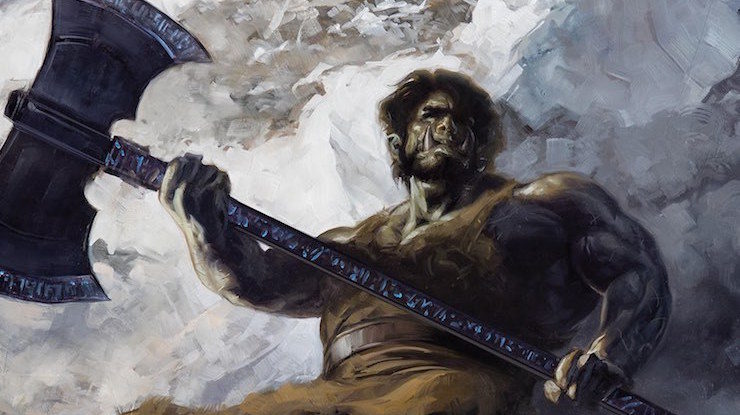As a youngster in the late seventies, I never would have guessed that 2017 would be a big year for trolls. Some of my earliest memories involve obsessing over the Moomins, cute trollish creatures from Scandinavia that looked like bipedal hippos. A couple years later my focus shifted to the book Gnomes, by Will Huygen, which depicts gnomes’ hidden struggles against monstrous trolls bent on capturing and eating them. These hirsute, grisly depictions of the enemy affected my dreams. Then, the Rankin & Bass illustrated edition of The Hobbit carried me deeper into fantasy; I wanted to be the characters in that world, fight against the same foes, or better yet, make friends with the trolls, goblins, and elves. I couldn’t get enough of Norse and Greek mythology, fascinated not as much by the famous exploits of the gods, but with the less defined stories of the giants, titans, and lesser monsters that had existed before the gods were even born.
What were these ancient elemental beings that were bound to the land only to fight and fall against the civilizing press of humanity? Why have they fascinated me, and so many others, since childhood and into adulthood? The world “troll” comes from Old Norse, and refers to an ill-defined class of supernatural beings from Norse and Scandinavian folklore. Some saw them as cognates of “giants” and “elves,” but over the centuries “trolls” have taken on an identity unto themselves—at times similar and/or related to both giants and elves, or perhaps even the result of shared blood between the two species.
Today, we have seen a resurgence of “trolls” in popular consciousness: as petty people that revel in sowing discord on the Internet; an animated movie voiced by some of our most adorable celebrities; Trollhunters is a hit Netflix show by one of our era’s fantasy masters, Guillermo del Toro; and Neil Gaiman has produced a fresh bestseller by returning to the Old Norse tales from whence the trolls first came.
I wonder if trolls don’t represent an important function in the subconscious of the present zeitgeist. The elemental powers of the giants that fought against the structured paradigm of civilization have died out and been forgotten. But as the climate changes due to humanity’s unchecked influence, and the natural world slips back toward a state of chaos, the old blood of the giants stirs again in the trolls—not passive and willing to fade quietly, like the elves and faeries, but angry, monstrous, and ready to fight back…
Here are five books about these mercurial creatures that have influenced me over the years, as relevant today as they ever were, and perhaps more so:
The Three Billy Goats Gruff by Peter Christen Asbjornsen & Jorgen Moe
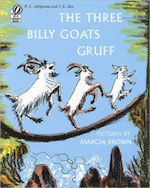 First collected and published in the 1840s, this Norwegian folk tale is likely the origin of the relationship between trolls and bridges. The troll does not come across as particularly clever, and the moral boils down to eat the first goat you find and save room for seconds. (I want more from my trolls. The myths spoke of them as being great magicians and brilliant tacticians as often as they were represented for their brute strength and savage nature. Trolls can be complex.)
First collected and published in the 1840s, this Norwegian folk tale is likely the origin of the relationship between trolls and bridges. The troll does not come across as particularly clever, and the moral boils down to eat the first goat you find and save room for seconds. (I want more from my trolls. The myths spoke of them as being great magicians and brilliant tacticians as often as they were represented for their brute strength and savage nature. Trolls can be complex.)
The Moomins by Tove Jansson
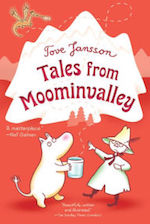 Though I do not have a solid recollection of these books and shows, I remember loving them at the time. These complicated hippo-like trolls were capable of emotional depth as they embarked on episodic adventures throughout a fairy and animal bedecked wilderness. The insightful tone of the loosely strung vignettes, both comforting and a little sinister, speaks effortlessly to childhood learning. The Moomin family displays nothing of the monstrous nature so often ascribed to troll kind, more concerned with philosophical thinking and self-assured action. (I love their thoughtfulness and belonging to the natural world, but I want my trolls to have earned a bit of their nightmarish reputation.)
Though I do not have a solid recollection of these books and shows, I remember loving them at the time. These complicated hippo-like trolls were capable of emotional depth as they embarked on episodic adventures throughout a fairy and animal bedecked wilderness. The insightful tone of the loosely strung vignettes, both comforting and a little sinister, speaks effortlessly to childhood learning. The Moomin family displays nothing of the monstrous nature so often ascribed to troll kind, more concerned with philosophical thinking and self-assured action. (I love their thoughtfulness and belonging to the natural world, but I want my trolls to have earned a bit of their nightmarish reputation.)
Gnomes by Wil Huygen
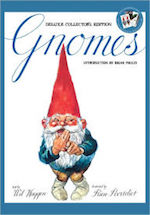 This one filled some of my earliest fantasy needs. The hidden world of the gnomes, and the trolls that hunted them, seemed oddly plausible to me. There was at least a full year when I must have flipped through those pages every day. (Again, these trolls were fairly one-sided and dim-witted, but their base, earthen savagery stayed with me and felt right.)
This one filled some of my earliest fantasy needs. The hidden world of the gnomes, and the trolls that hunted them, seemed oddly plausible to me. There was at least a full year when I must have flipped through those pages every day. (Again, these trolls were fairly one-sided and dim-witted, but their base, earthen savagery stayed with me and felt right.)
The Hobbit by J.R.R. Tolkien
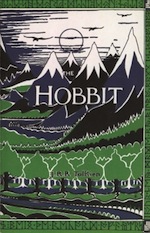 I almost skipped this one as it seemed too obvious—to be honest, it was the Rankin Bass cartoon version more than the book itself that so profoundly spoke to early me—but to omit it would be inauthentic to my trollish thinking. Three Stone trolls, Tom, Bert, and William Huggins, capture and discuss the eating of our fourteen heroes after a botched burglary attempt. These trolls are once again pretty dumb, but they make quick work of what are supposed to be an elite collection of dwarves who are only saved by the last minute cleverness of the Wandering Wizard. (The aforementioned savagery and greater fantasy world context for the trolls in this one showed me, and us all, the scope of what trolls, at their brutish best, could be. They had names, clothes, personalities, and a cave full of ancient booty. There was a treasure trove of unexplored myth there as well.)
I almost skipped this one as it seemed too obvious—to be honest, it was the Rankin Bass cartoon version more than the book itself that so profoundly spoke to early me—but to omit it would be inauthentic to my trollish thinking. Three Stone trolls, Tom, Bert, and William Huggins, capture and discuss the eating of our fourteen heroes after a botched burglary attempt. These trolls are once again pretty dumb, but they make quick work of what are supposed to be an elite collection of dwarves who are only saved by the last minute cleverness of the Wandering Wizard. (The aforementioned savagery and greater fantasy world context for the trolls in this one showed me, and us all, the scope of what trolls, at their brutish best, could be. They had names, clothes, personalities, and a cave full of ancient booty. There was a treasure trove of unexplored myth there as well.)
Beowulf
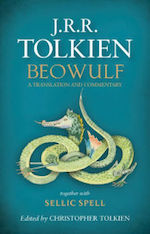 My friends and I turned this one into a comedic movie for a ninth grade school project. Making it was some of the most fun I’ve ever had—we all got A’s. Though it’s a topic of much debate among those who debate such things, Grendel, Grendel’s Mother, and even the dragon can be viewed as trolls. Grendel coming to Heorot to destroy the hall because of the din made there is akin to the Scandinavian belief that early church construction and bell ringing was often met by troll attack. Grendel is the consummate troll in appearance and action, but his mother is just as iconic in her representation as a powerful shape-shifting trollhag capable of birthing monsters—just as Angrboda birthed Jormungand, Fenris Wolf, and Hel in Norse myths. (These vengeful and powerful beings laid further foundation for the trolls I sought to emulate.)
My friends and I turned this one into a comedic movie for a ninth grade school project. Making it was some of the most fun I’ve ever had—we all got A’s. Though it’s a topic of much debate among those who debate such things, Grendel, Grendel’s Mother, and even the dragon can be viewed as trolls. Grendel coming to Heorot to destroy the hall because of the din made there is akin to the Scandinavian belief that early church construction and bell ringing was often met by troll attack. Grendel is the consummate troll in appearance and action, but his mother is just as iconic in her representation as a powerful shape-shifting trollhag capable of birthing monsters—just as Angrboda birthed Jormungand, Fenris Wolf, and Hel in Norse myths. (These vengeful and powerful beings laid further foundation for the trolls I sought to emulate.)
My trolls in Cold Counsel, SLUD and Agnes, are amalgams of the depictions in all these books, and many others. They are calculating and powerful, possessing of ancient wisdom and still hungry to learn, flawed and complex, yet sometimes base and simplistic at the same time. Equal parts dangerous and inviting, they are the watchers over dark dreams and bright nightmares. I wanted to uncover their histories and secrets; I hope you do too.
 Chris Sharp grew up in the suburban wonderland of Alexandria, VA, where he cut his nerd teeth playing role-playing games and making gore movies with his friends. He studied English Literature and Anthropology at Brown University, and Mayan Archaeology at the Harvard Field School in Honduras. He then spent sixteen years in Brooklyn, NY, where he worked in film and commercial production by day, and was yet another wannabe novelist by night. His epic fantasy novel, Cold Counsel, is available from Tor.com Publishing. Chris now lives in Concord, MA, with his wife, daughter and an insufferable cat named Goblin.
Chris Sharp grew up in the suburban wonderland of Alexandria, VA, where he cut his nerd teeth playing role-playing games and making gore movies with his friends. He studied English Literature and Anthropology at Brown University, and Mayan Archaeology at the Harvard Field School in Honduras. He then spent sixteen years in Brooklyn, NY, where he worked in film and commercial production by day, and was yet another wannabe novelist by night. His epic fantasy novel, Cold Counsel, is available from Tor.com Publishing. Chris now lives in Concord, MA, with his wife, daughter and an insufferable cat named Goblin.










